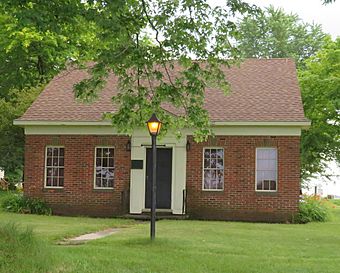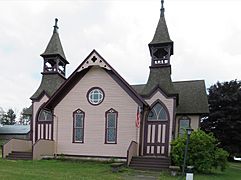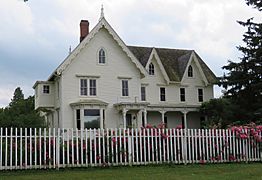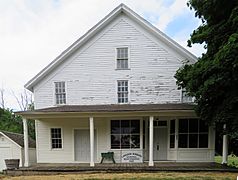Huron City Historic District facts for kids
Quick facts for kids |
|
|
Huron City Historic District
|
|

Lakeview House
|
|
| Location | Pioneer Dr., Huron and Port Austin Townships, Huron City, Michigan |
|---|---|
| Area | 93 acres (38 ha) |
| Built | 1856 |
| Architectural style | Stick/eastlake |
| NRHP reference No. | 95000446 |
| Added to NRHP | April 28, 1995 |
The Huron City Historic District is a special place in Huron City, Michigan. It's like a preserved old village that shows what life was like long ago. Many of its buildings are found along Pioneer Drive. This district was added to the National Register of Historic Places in 1995 because of its important history.
Contents
A Look Back: Huron City's Story
Early Days and Lumber
Huron City started because of the big lumber boom in the area. This means there was a lot of wood to cut down and sell. A sawmill, which cuts logs into planks, was built here in the 1830s or 1840s. By 1852, a company called P. F. Brakeman & Co. was running a sawmill powered by water.
Later, a family of brothers and their cousin, Langdon, Watson, and Rollin Hubbard, took over the mill. Their company, R. B. Hubbard & Co., started to build up the Huron City operation in the mid-1850s. By 1867, Langdon Hubbard was in charge of everything in Huron City.
Fires and Rebuilding
By 1871, the Hubbard sawmill was very busy, making about 40,000 board feet of lumber every day! A small town had grown up around the mill. However, the Great Michigan Fire of 1871 completely destroyed the town.
Langdon Hubbard didn't give up. He rebuilt Huron City. By 1875, the sawmill was working again, and the village had a store, a hotel, a school, and many houses. After this fire, Langdon Hubbard slowly gained control of the entire settlement. But then, in 1881, the Thumb Fire hit, and Huron City was completely destroyed again. Langdon Hubbard lost a lot of money, about $50,000.
A New Start and Decline
Even after two huge fires, Hubbard rebuilt Huron City once more. He built a grist mill (for grinding grain), another sawmill, a boardinghouse, a hotel, a school, stores, and many homes. The sawmill was still running, but there wasn't much local timber left. More people were also coming to the area to farm. This allowed Hubbard to sell the land that used to be covered in trees.
Langdon Hubbard passed away in 1892. Without him, Huron City slowly started to fade. The hotel closed in 1901, and the mill closed in 1903. By 1907, there was only one business left in town.
Preservation Efforts
Luckily, Langdon Hubbard's daughter, Annabel, had married a famous professor named William Lyon Phelps in 1892. The couple spent their summers in Huron City almost every year until Annabel's death in 1938. The Phelpses owned most of Huron City. They helped the village change from a busy mill town to a quiet country place. They kept the old hotel as a community spot and even replanted parts of the village.
After Annabel died, Professor Phelps gave control of the town to his niece, Carolyn Hubbard Parcells. Carolyn and her husband, Charles, started a project to save Huron City's history. In 1946, they created the William Lyon Phelps Foundation. This foundation built a museum and restored the old general store and hotel, helping to preserve Huron City for future generations.
Exploring Huron City's Historic Buildings
The Huron City Historic District has many old buildings. Most of them were built in the mid-1880s, after the big Thumb Fire. Some buildings, like the LaGassa Log House and the Point aux Barques U. S. Life-Saving Station Building, were moved here from other places to be preserved. These buildings are mostly found along Pioneer Drive. Let's take a look at some of them:
- Cemetery: This half-acre cemetery has 12 marked graves. The oldest one belongs to Langdon Hubbard, who was so important to the town.
- Allen House: This house was likely built in the 1880s. It's a 1-1/2 story building with a T-shape and a front-gable roof. It has a one-story wing on each side and is covered with clapboard siding.
- Hubbard Grist Mill site: A grist mill was built here in 1883. Today, there are no visible parts of it left.
- Hubbard Saw Mill site: At least two sawmills were built on this spot after the fires. Earlier mills might have been here too. Like the grist mill, there are no visible parts left today.
- Langdon Hubbard General Store: This is a large, two-story building with a front-gable roof. It stands on a stone foundation and is covered with clapboard. A porch runs all the way across the front. The store sold everything from groceries to hardware.
- Pottenger House: This two-story house was built in the 1880s. It was the home of William Pottenger, who managed the town for the Phelps family.
- Langdon Hubbard House: This T-shaped, two-story house has a cross-gable roof. It features Gothic-style windows and decorative trim called bargeboards. A front porch stretches across the building. It was built in two parts, in 1881 and 1886.
- LaGassa Log House: This is a one-story, rectangular log cabin made of logs cut into squares. It was built in the late 1830s or early 1840s by Mitchell and Delia LaGassa about two miles away. It was moved several times, finally arriving at its current spot in 1958 or 1960. It was used as a granary and later as a tea house.
- Hubbard Memorial Church: This church has a cross-gable roof and is covered in clapboard. It was first built in 1883, and more parts were added in the 1920s.
- Lakeview House: This building was a hotel, built in 1883-84. It's a two-story building with a front-gable roof and a porch across the front. It now serves as a museum, showing visitors what life was like in Huron City.
- Point aux Barques U. S. Life-Saving Station Building: This station was originally opened in 1876 on the lake shore, about two miles east of here. It was moved to this spot in 1964 to keep it safe. It's a wooden building with two parts: a 1-1/2-story section for life-saving equipment and an attached 1-1/2-story home and office for the station's captain.
Gallery







